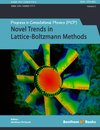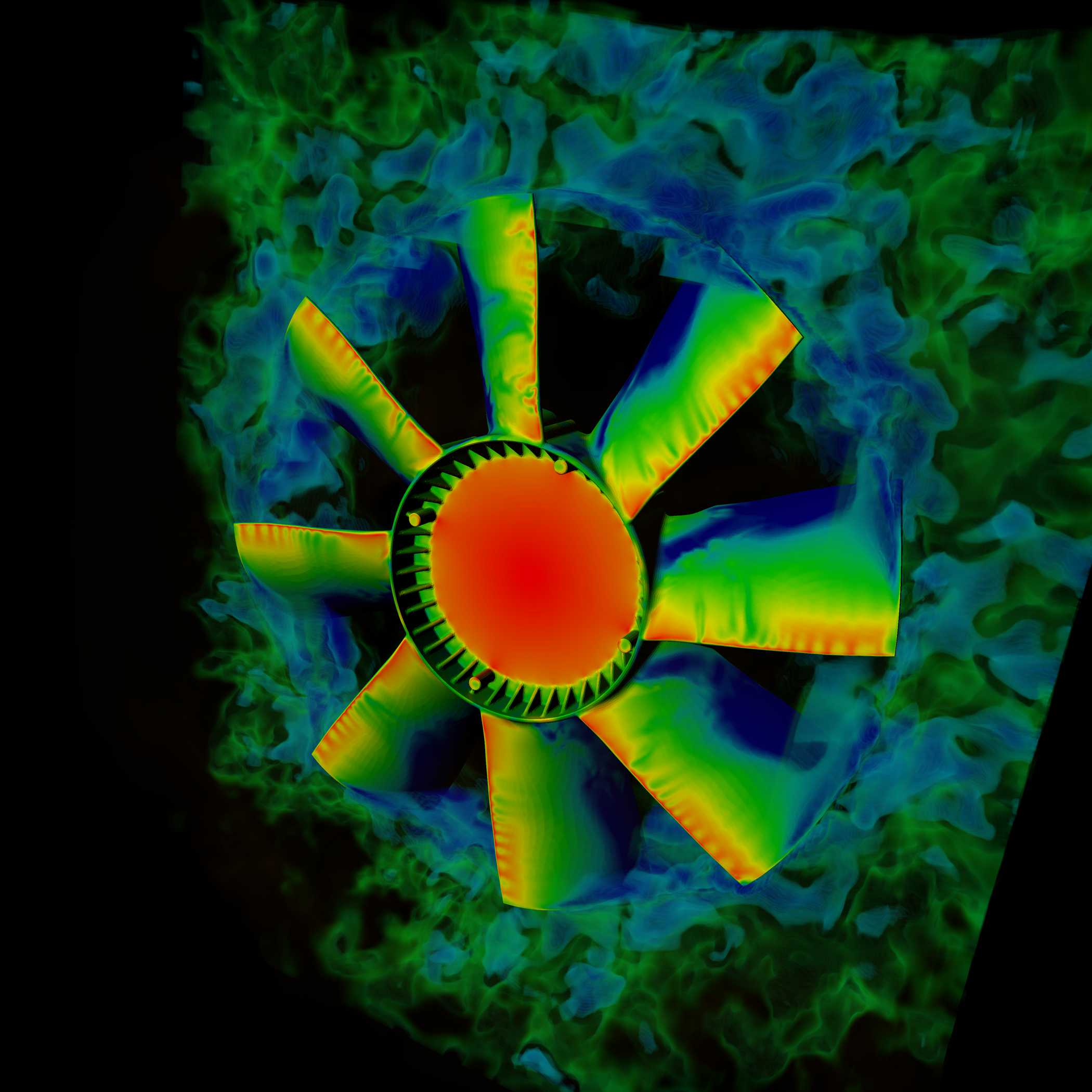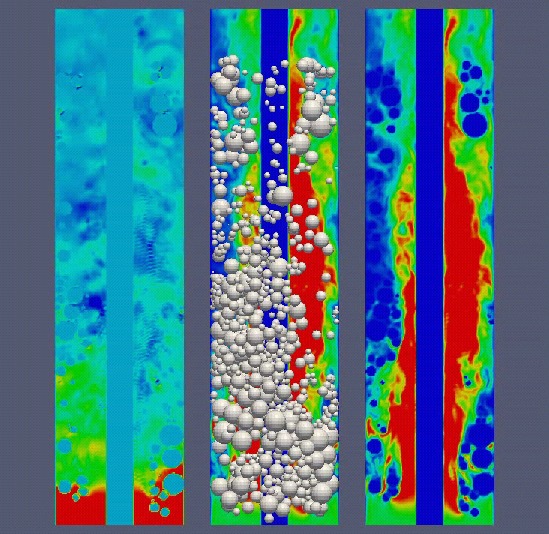
|
Bergische Universität Wuppertal
|

|
|

|
Bergische Universität Wuppertal
|

|
|
Novel Trends in Lattice Boltzmann MethodsReactive Flow, Physicochemical Transport and Fluid-Structure InteractionMatthias Ehrhardt (ed.)E-Book Series Progress in Computational Physics (PiCP), Volume 3Bentham Science Publishers, June 2013.Book Webpage at Publisher |
|

[click to enlarge] |
 |
Left figure:
Commercial vehicle fan simulated by Exa PowerFLOW and visualized using Exa PowerVIZ. Right figure:
Cutting transport in drill pipe (pressure, velocity with cuttings, velocity). |
 |
Subject:
This third volume contains, 9 chapters devoted to mathematical analysis of different issues related to the lattice Boltzmann methods, advanced numerical techniques for physicochemical flows and fluid structure interaction and practical applications to real world problems.
Purpose: The purpose of this book is to give an overview on the current state-of-the-art research on lattice Boltzmann methods and their possible impact in applications.
The book is designed to be consisting of a collection of contributed chapters. Outstanding experts working successfully in this challenging research area will be invited to contribute each a chapter of roughly 30-40 pages to this volume.
Academic Level: The principal audience is Ph.D. students and lecturer of computational physics, chemistry and numerical mathematics and also engineers working in this application fields.
by Hudong Chen, Exa Corporation, Burlington, MA, USA.
Lattice Boltzmann Methods, (2 pages)
by Matthias Ehrhardt, Lehrstuhl für Angewandte Mathematik und Numerische Mathematik, Fachbereich Mathematik und Naturwissenschaften, Bergische Universität Wuppertal, Wuppertal, Germany.
An Introduction to the Lattice Boltzmann Method for Coupled Problems (28 pages)
by Daniel Heubes, Andreas Bartel and Matthias Ehrhardt, Lehrstuhl für Angewandte Mathematik und Numerische Mathematik, Fachbereich Mathematik und Naturwissenschaften, Bergische Universität Wuppertal, Wuppertal, Germany.
Abstract: The first part of this introductive chapter is devoted to the known derivation of the lattice Boltzmann method (LBM) from the Boltzmann equation using finite differences. Thereby the collision term is approximated with a single relaxation time model (BGK) and also a multi-relaxation-time model is shortly presented. By applying a multiscale expansion (Chapman-Enskog), the solution of the numerical method is verified as a meaningful approximation of the solution of the Navier-Stokes equations. To state a well posed problem, common boundary conditions and force terms are introduced and their realization within a LBM is discussed.
In the second part, the LBM is extended to handle coupled problems. Three cases are investigated: (i) the movement of objects in a flow, (ii) the coupling to heat transport, (iii) coupling electric circuits with power dissipation (as heat) and heat transport.
Add-ons for Lattice Boltzmann Methods: Regularization, Filtering and Limiters (22 pages)
by Robert A. Brownlee, Jeremy Levesley, David Packwood and Alexander N. Gorban, Department of Mathematics, University of Leicester, United Kingdom.
Abstract: In this chapter we describe how regularization of lattice Boltzmann methods (LBMs) can be achieved by dampening systems using controlled numerical dissipation. Classes of techniques used to try to improve regularization of LBMs include entropic limiters, enforcing the exact correct production of entropy and manipulating non-hydrodynamic modes of the system in relaxation. Where effective, each of these techniques corresponds to an additional injection of dissipation compared with the standard LBGK model. Using some standard 1D and 2D benchmarks including the shock tube and lid driven cavity, we explore the effectiveness and accuracy penalties of these classes of methods.
Discrete-Velocity Models and Lattice Boltzmann Methods for Convection-Radiation Problems (36 pages)
by Mapundi K. Banda, School of Computational and Applied Mathematics, University of the Witwatersrand, South Africa
and Mohammed Seaïd, School of Engineering and Computing Sciences, University of Durham, United Kingdom.
Abstract: Discrete-velocity models and lattice Boltzmann methods (LBMs) are presented for solving convection-radiation effects in thermal fluid flows. The discrete-velocity equations are derived from the continuous Boltzmann equation with appropriate scaling suitable for incompressible flows. The radiative heat flux in the energy equation is obtained using the discrete-ordinates solution of the radiative transfer equation. This chapter is structured in two parts. In the first part we investigate the derivation of the discrete-velocity models and we perform an asymptotic analysis to show at the leading order the macroscopic models are recovered from these discrete-velocity models. In this part we also formulate the LBM for solving the convection-radiation problems. The second part of this chapter is devoted to the computational aspects of the considered models. Consistent boundary and initial conditions in the lattice Boltzmann models are also discussed in this part. Numerical results are presented for several test examples on coupled convection-radiation flows in two dimensional enclosures. Detailed simulation results at different flow and radiative regimes, as well as benchmark solutions, are also presented and discussed. The obtained results show that the developed models are competitive tools for convection-radiation problems.
Asymptotic Analysis of Lattice Boltzmann Methods for Flow-Rigid Body Interaction (36 pages)
by Alfonso Caiazzo, Weierstrass Institute for Applied Analysis and Stochastics, Berlin, Germany
and Michael Junk, Fachbereich Mathematik und Statistik, Universität Konstanz, Germany.
Abstract: In this chapter we perform a detailed asymptotic analysis of different numerical schemes for the interaction between an incompressible fluid and a rigid structure within a lattice Boltzmann (LB) framework.
After introducing the basic ideas and the main tools for asymptotic analysis of bulk LBM and boundary conditions, we concentrate on moving boundary LB schemes. In particular, we investigate in detail the initialization of new fluid nodes created by the variations of the computational fluid domain, when a solid objects moves through a fixed computational grid. We discuss and analyze the equilibrium-non equilibrium (EnE) refill algorithm, reporting comparisons with other methods, based on numerical and theoretical considerations.Secondly, we focus on force computation through Momentum Exchange Algorithm (MEA). Starting from the original scheme (as proposed by Ladd), we introduce a correction which, motivated by the analysis, improves Galilean invariance properties of the force computation. We show that this correction plays a critical role in particular applications. Moreover, precise accuracy estimates for the force computation are derived. Our analysis yields first order accuracy of the global force computation, while it shows that the classical MEA is not suitable for accurate local forces evaluation. This problem is fixed with the proposed modification.
The theoretical results are supported by several numerical experiments, considering both ad-hoc designed benchmarks, to validate accuracy properties of the schemes, and more general test setups.Lifting for Lattice Boltzmann Models (28 pages)
by Ynte Vanderhoydonc, Universiteit Antwerpen, Belgium.
and Wim Vanroose, Universiteit Antwerpen, Belgium.
and Christophe Vandekerckhove, ArcelorMittal,
and Pieter Van Leemput Department of Computer Science, Faculty of Applied Sciences, Katholieke Universiteit Leuven, Belgium.
and Dirk Roose, Department of Computer Science, Faculty of Applied Sciences, Katholieke Universiteit Leuven, Belgium.
Abstract: In this chapter we give an overview of the various lifting strategies for Lattice Boltzmann Models (LBM). A lifting operator finds for a given macroscopic variable the corresponding distribution function. This is, for example, useful in coupled LBM and PDE models, where one part of the domain is described by a PDE while another part is modeled by an LBM. At the interface between these models the lifting operator provides the correct boundary conditions for the LBM domain. Lifting operators are also useful in the development of efficient multilevel solution techniques. We discuss the accuracy, computational cost and convergence rate of analytical and numerical lifting procedures.
Multiscale Lattice Boltzmann methods for reaction-diffusion processes in chemically and physically heterogeneous environment (29 pages)
by Davide Alemani, EPFL, Lausanne, Switzerland.
Abstract: This chapter explains the recent progress of the lattice Boltzmann method (LBM) applied to diffusion-reaction processes for chemical and environmental applications, in particular to physicochemical processes that take place in environmental systems, such as aquatic systems, porous media, sediment, soils and biofilm layer on inert substrate. The inherently multiscale problem in space and time of such types of applications has been investigated via the combination of two techniques, the time splitting and the grid refinement methods. We present recent interesting results on metal flux (biouptake) and dynamic speciation at bio-interface in ligand mixtures specifically on the roles of simple, fulvic and aggregate complexes on metal of particular interest for their ecotoxicology (for example Pb) in freshwater ligand mixtures at planar consuming interfaces.
Furthermore, the role of Michaelis-Menten boundary condition at consuming interface will be investigated. These results have been obtained by using a new computer program MHEDYN developed by the author to compute metal fluxes at planar consuming surfaces in multiligand, chemically heterogeneous environmental systems. Further extension of the model with the inclusion of convection driven by chemical gradient will be discussed. Furthermore, we will discuss the possible extension of MHEDYN in the multiscale-multiscience framework (the MAPPER project) for modelling and simulation of complex systems based on hierarchical aggregation of coupled models.
A Lattice Boltzmann Method for Coupled Fluid Flow, Solute Transport, and Chemical Reaction (14 pages)
by Qinjun Kang and Peter Lichtner, Computational Earth Science Group (EES-16), Earth and Environmental Sciences Division, Los Alamos National Laboratory, Los Alamos, USA.
Abstract: We present in this chapter a lattice Boltzmann method (LBM) for modeling coupled fluid flow, solute transport, and chemical reaction at a fundamental scale where the flow is governed by continuum fluid equations. Our numerical model accounts for multiple processes, including fluid flow, diffusion and advection of species, ion-exchange and mineral precipitation/dissolution reactions, as well as the evolution of pore geometry due to dissolution/precipitation. Homogeneous reactions are described either kinetically or through local equilibrium mass action relations. Heterogeneous reactions are incorporated into the LBM through boundary conditions imposed at the mineral surface. The LBM can provide detailed information on local fields, such as fluid velocities, solute concentrations, mineral compositions and amounts, as well as the evolution of pore geometry due to chemical reactions. Simulation examples include flow in a channel coupled with different reactions (linear kinetics for a single component, nonlinear kinetics for multi-components, and ion exchange reaction with constant Kd); crystal growth from supersaturated solution; and injection of CO2 into a limestone rock.
A Lattice Boltzmann Approach for Distributed Three-dimensional Fluid-Structure Interaction (17 pages)
by Sebastian Geller, Christian Janßen and Manfred Krafczyk, Institut für rechnergestützte Modellierung im Bauingenieurwesen (iRMB), Technische Universität Braunschweig, Germany.
Abstract: This chapter investigates the validity and efficiency of the coupling of the lattice Boltzmann method with finite elements schemes as well as rigid body approaches to model fluid-structure interaction (FSI). The results on two- and three-dimensional benchmark configurations are very promising and show that an explicit coupling scheme is able to produce accurate results which agree with reference solutions very well. The underlying fluid solver VirtualFluids is based on adaptive hierarchical grids and component technology for parallelization. One target application is the simulation of a jet induced by a ship propeller which poses a substantial challenge to both the numerical scheme as well as to the software parallelization concept. Furthermore, the coupling to a rigid body dynamics engine (PhysicsEngine-pe) leads to the possiblity to compute FSI problems with a huge number of particles which is the basis for numerical simulations in geothermic drilling, where the particles eroded by the drill head influence the fluid dynamics. A free surface lattice Boltzmann approach coupled with rigid body motions shows further potential and demonstrates the broad applicability of the developed algorithms.
Lattice Boltzmann Method for MILD Oxy-fuel Combustion Research: A Potential Powerful Tool Responding to the Man-made Global Warming (51 pages)
by Sheng Chen, US-China Clean Energy Research Center, China-EU Institute for Clean and Renewable Energy, State Key Laboratory of Coal Combustion, Huazhong University of Science and Technology, P.R. China.
Abstract: The subject of this chapter is the numerical simulation/modeling of multicomponent combustion under MILD oxy-fuel operation by the lattice Boltzmann method (LBM) to deepen our understanding on this novel combustion technology and improve related methodologies, which represents a significant challenge in the combustion community to respond to the man-made global warming. The main objective is to demonstrate the opportunities to build a new modeling framework to accelerate scientific discovery in this topic by utilizing unique features of the LBM and indicate the challenges that we should overcome since until recently the LBM could not be employed in such research due to combustion's inherent complexity. The relevant preliminary explorations, including that by the present author, are discussed. Further development of the methodology would not only provide the basis for a new platform to accelerated scientific research in combustion science, but also significantly push back of the limits of LBM in general.
|